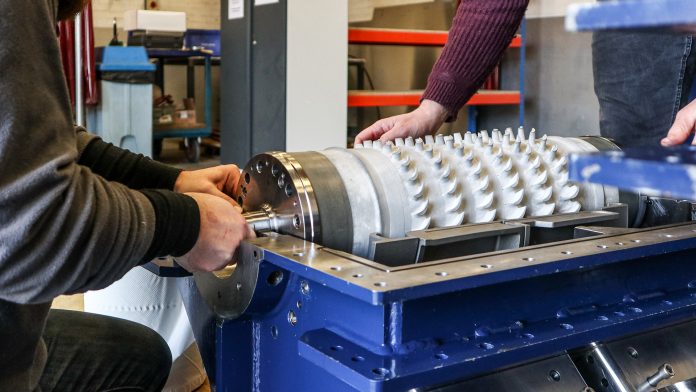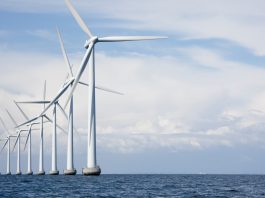Toby Gill, CEO of Intelligent Power Generation, explains how the Flameless Ceramic Turbine can unlock the roadmap to renewable fuels and enable businesses to end their reliance on the diesel generator.
Fuel-based power is useful. Our infrastructure, our economy, and our way of life has been built around the use of fuels and the role they play in providing power exactly when and where it is needed. This role is still vital, even in a wind- and solar-dominated energy system.
So, what if we do not have to stop using it?
On the face of it, this is quite a controversial statement, especially when you consider the impact our continued burning of fossil fuels is having on both the environment and human health. But, in fact, it is the specific fuels widely available today and the power generation technologies we use that contribute to rising carbon emissions and declining air quality – but they do not have to.
The growing availability of hydrogen, biofuels, and other waste biogases, alongside technological innovations in efficiency and the elimination of pollutant emissions, all offer a route to bring fuel-based power generation in line with our renewable and clean air future.
At IPG we are developing the Flameless Ceramic Turbine – a first of its kind 100kW modular generator designed to deliver pollutant-free power from any renewable fuel, all at a cost competitive with the diesel generator.
Through our breakthrough flameless combustion and novel use of simple, low-cost ceramics, our turbine technology is set to change the way industries and businesses generate power and help to accelerate our green energy transition.
Clean, fuel-based power us vital as we transition to the green economy
As our world strives to decarbonise and mitigate our climate impact, we are deepening the need for energy infrastructure that is equally renewable, affordable, and secure. Whilst wind and solar now offer some of the cleanest and cheapest power available, organisations like the International Energy Agency (IEA) still project fuel to be the principal source of energy in 2040.1 This is because fuel is dispatchable and easily transportable, two key qualities essential for maintaining energy security for businesses, industries, and countries alike.
Innovators in wind, solar, and battery storage are increasingly challenging this projected dominance, particularly in centralised power grids. But the role of distributed fuel-based power will still be vital. As well as providing grid-independent power where on-site wind and solar is not practical or economically feasible, fuel delivers the resilience and flexibility needed to support the large-scale integration of wind and solar in our energy grid. For any fuel-based power solution to continue to play this role in our energy mix, it must support wind, solar, and battery storage to deliver on our carbon emissions and air quality ambitions.
Hydrogen and biofuels
Switching to hydrogen and biofuels is the only way we can decarbonise fuel-based power. The barrier, however, for businesses investing in renewable-fuelled technologies lies in the uncertainty around which fuels and in which timelines this renewable fuel infrastructure will materialise.
The reality is that the future of the fuel market lies somewhere between pure green hydrogen and a fragmented landscape of net-zero- and zero-carbon fuels, all of which is likely to be geographically specific. Existing products are fuel specific, meaning businesses that want to decarbonise need to stake a bet on specific alternative fuels, which creates risk and is limiting adoption. Equally, many of those technologies use a flame during the combustion process, thereby producing the pollutant emissions harmful to human health.
IPG’s Flameless Ceramic Turbine
In today’s uncertain and evolving fuel landscape, fuel-flexibility is crucial to decarbonising fuel-based power by de-risking the switch to renewable fuels for businesses. IPG is the first company to commercialise fuel-flexible flameless combustion in small-scale power generation, bringing to market a product that will enable industries and businesses to reduce carbon emissions and impact on air quality.
Zero-pollutant power from any renewable fuel
In conventional combustors, different fuel types require bespoke solutions to sustain a flame, meaning different fuels require different products. Through our breakthrough flameless combustion, we have eliminated the flame and therefore eliminated the design complexities surrounding the flames from different fuels. This means IPG’s turbine can literally ‘burn’ any fuel, no matter the quality or calorific value, be that hydrogen, biogas, landfill gas, or even ammonia.
Our advancements in flameless combustion are also how we have eliminated all pollutant emissions from fuel-based power generation. Nitrogen oxides, particulate matter, and carbon monoxide not only impact our air quality, but also have a greenhouse gas effect. They, however, are not a product of the fuels themselves, but rather the way we burn them.
By eliminating the flame, not only can our turbine operate on any fuel, as and when it becomes available, it does so without producing pollutant emissions.
Power plant efficiencies for low-cost power
Ceramic turbine design dates back to the 1960s for their ability to withstand greater operational temperatures compared to conventional metals and achieve higher efficiencies. By designing our turbine to be fabricated from low-cost ceramics, balancing high-temperature performance with strength at speed, our system can withstand operational temperatures of 1,250°C without the need for complex composites, alloys, or intra-blade cooling.
Using our expertise in interfacing ceramics with metals, we have also developed a ceramic heat regeneration system which works to sustain those high temperatures and reduce fuel use by recovering waste heat. The innovative rotary design and honeycomb ceramic structure is designed to maximise surface area for high-temperature heat exchange, in a compact and low-cost way.
Our innovations in ceramic turbine design and compact waste heat recovery combine to secure efficiencies comparable to a centralised gas power plant. These high efficiencies reduce fuel usage and therefore costs, helping to offset the higher costs of renewable fuels, relative to diesel. This then combines with our use of low-cost, widely available materials, as well as existing manufacturing practices to ensure a levelised cost of energy competitive with the diesel generator.
Prototype set for rapid commercialisation
For the last two years IPG has been working with Cranfield University to develop and test the core components of our turbine system, and to build the first 100kW prototype of our Flameless Ceramic Turbine. This work forms part of a £1m pilot project with Highways England and Innovate UK to demonstrate our Flameless Ceramic Turbine as a pollutant-free, grid-independent power solution for UK EV charging infrastructure.
The full-scale prototype is nearing completion, ready to provide pollutant-free, low-carbon power to Cranfield University’s mini-grid and the university’s EV charging outlets. The success of this pilot project paves the way for market entry in 2023 of a product that can enable businesses, not only in EV charging but across a range of applications, including construction, mining and grid balancing, to end their reliance on the diesel generator.
Now, IPG is looking to engage with pioneering companies to help accelerate the commercialisation of our product and join our commercial trials beginning early next year. If you are interested to learn more about how our Flameless Ceramic Turbine can help your business achieve your climate goals, please contact us.
References
- International Energy Agency, World Energy Outlook 2019
Please note, this article will also appear in the fifth edition of our quarterly publication.









